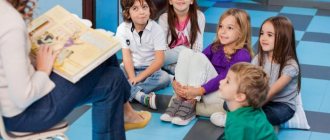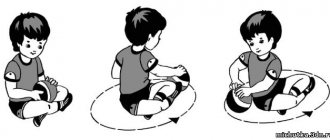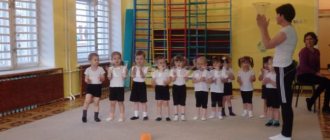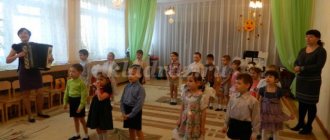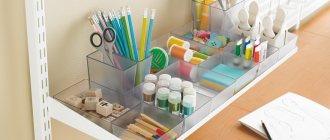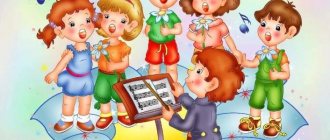Article: “Physical education in kindergarten”
Starting from the second junior group, three classes per week are planned. Their duration in the junior group is at least 15 minutes, in the middle group - at least 20 minutes, in the senior group - at least 25 minutes, in the preparatory group - 30 minutes. If children have sportswear and there are no medical contraindications, one of the three physical education classes in the senior and preparatory groups should be held outdoors year-round. For regions of the middle zone in the winter season, physical education classes on the site, as well as walking for children 5–7 years old, are not carried out at air temperatures below –20°C and wind speeds of more than 15 m/sec. In the warm season, under favorable weather conditions, it is recommended to conduct the maximum number of activities outdoors. There are various options for conducting physical education classes:
traditional classes;
classes consisting of a set of outdoor games of high, medium and low intensity;
classes – training in basic types of movements;
Rhythmic gymnastics;
classes-competitions, where children identify the winners during various relay races of two teams;
test classes, during which children pass physical education standards;
story-based activities, etc.
Physical education and health work includes morning exercises, outdoor games and physical exercises on walks (morning and evening), and a physical exercise minute. Morning exercise helps to awaken the child’s body, moderately affects the muscular system, activates the activity of the cardiovascular, respiratory and other body systems, stimulates the work of internal organs and sensory organs, promotes the formation of correct posture, good gait, and prevents the occurrence of flat feet. Morning exercises are valuable because children develop the habit and need to do physical exercise every day in the morning. In addition, it provides an organized start to the day in kindergarten and makes it possible to switch children’s attention to joint forms of activity. The duration of morning exercises in the 1st junior group is 4-5 minutes, in the 2nd junior group - 5-6 minutes, in the middle group - 6-8 minutes, in the senior group - 8-10 minutes, in the preparatory group - 10-12 minutes. The optimal place for morning exercises in the warm season is the group's playgrounds, and in the cold season - the group room. Depending on the ambient temperature, children exercise in lightweight clothing or panties. In the health complex of morning exercises, in addition to general developmental exercises. They include breathing exercises and special exercises to strengthen the muscles of the back and foot. Health jogging of varying intensity for 3 minutes. Particular attention is paid to improving the functions of external respiration, for which children are taught to combine movement with inhalation and exhalation, include so-called “breathing exercises” with the pronunciation of sounds and syllables, and pay attention to the formation of correct nasal breathing. Children's stay in the fresh air is of great importance for physical development. Walking is the first and most accessible means of hardening a child’s body. It helps to increase its endurance and resistance to adverse environmental influences, especially colds. During the walk, children play and move a lot. Movement increases metabolism, blood circulation, gas exchange, and improves appetite. Children learn to overcome various obstacles, become more agile, dexterous, courageous, and resilient. They develop motor skills and abilities, strengthen the muscular system, and increase vitality. Properly organized and thoughtful walks help to achieve the goals of the comprehensive development of children. Children are allowed to spend up to four hours a day outdoors. In summer this time increases significantly. The daily routine of the kindergarten includes a daytime walk after classes and an evening walk after afternoon tea. The time allotted for walking must be strictly observed. On the site there are places for outdoor games and the development of children's movements: climbing fences (triangular, tetrahedral and hexagonal), a log for balance exercises, a slide, equipment for jumping and throwing exercises. All this should have an attractive appearance, be durable, well processed, secured and appropriate for the age of the children. Planning the content of children's activities during a walk depends on the time of year, weather, previous activities, interests and age. An important component of organized physical activity is outdoor games played during a walk in the first half of the day. To achieve an optimal training effect, use high-intensity outdoor games, sports games, competition games, relay races or running at an increasing pace for 3–5 minutes, depending on age (1–2 games or jogging, alternating them with periods of independent activity). In the summer, outdoor play is supplemented with elements of hardening (playing with water). They develop basic movements, relieve mental stress from classes, and develop moral qualities. An outdoor game can be played at the beginning of a walk if the activities involved children sitting for a long time. If they go for a walk after a music or physical education lesson, then the game can be played in the middle of the walk or half an hour before it ends. The choice of game depends on the time of year, weather, air temperature. On cold days, it is advisable to start your walk with games of greater mobility associated with running, throwing, and jumping. Fun and exciting games help children cope better with cold weather. In damp, rainy weather (especially in spring and autumn), sedentary games that do not require a lot of space should be organized. Games with jumping, running, throwing, and balance exercises should also be carried out on warm spring, summer days and early autumn. During walks, plotless folk games with objects can be widely used, and in older groups - elements of sports games: volleyball, basketball, gorodki, badminton, table tennis, football, hockey. In addition to outdoor games and individual exercises in basic movements, sports activities (exercises) are also organized during the walk. During the walk, the teacher makes sure that all the children are busy, not bored, and that no one gets cold or overheated. He attracts very active children to participate in calmer games. About half an hour before the end of the walk, the teacher organizes quiet games. The right combination of different types of daily physical exercise and outdoor games helps to ensure rational motor activity for children. Mastering the program material in the classroom is the basis for all physical education and recreational activities and independent exercises and games for children.
Summaries of non-traditional physical education classes by age
Notes of non-traditional physical education classes
by age
Summary of a non-traditional physical education lesson in the second junior group “The kids have become little frogs”
Target:
to form motor skills in children, to develop psychophysical qualities.
Tasks:
1) improve crawling under an arc, jumping into a hoop from a hoop, imitating the movements of frogs, walking like a snake;
Equipment:
box, frog toy, 2 arcs, 6 pins, 3 hoops, ribbons, frog hats according to the number of children in the group.
Progress of the lesson
Come closer to me. I'll show you something. You often meet an unusual animal. It is on the path, sometimes jumps out on the path, looks at you with its bulging little eyes and tries to hide again in the wet grass. And sometimes he jumps so fast that you can’t catch up. And when “kva-kva” starts talking, everyone recognizes him by his voice. Guess who's in my box! (toy) That's right, frog! Admire how smooth and slippery his suit is. And what color is it! That's right, green. Did everyone get a good look at it? I will put the open box on the ground, let the little frog jump in the grass and tell the mother frog how he visited us. This is how the little frog jumps quickly. Wave your arms at him.
Now put on your frog hats. Ready! Everything is fine! Let's start practicing, we will repeat the movements of the frog and do everything beautifully.
We walked one after another in a circle with our “paws” - we bent our arms at the elbows and spread them in different directions, we raised them up, lowered them down and even rotated them.
Slowly we ran after each other, moving our paws through the air. So we run, we look under our feet
We stopped. “Paws” - arms extended forward, turn them around, look at them on one side, on the other, clap your hands
They ran after each other again, faster, with their paws bent at the elbows and clapping their palms at the top.
They stopped, put their paws on my cheeks, turned their heads lightly to the side, and that’s it, everyone looked at me carefully
Open it wide, inhale, take in a lot of air and close your mouth. Now we calmly release it through the nose.
Warm-up with seaweed (bands).
Well done, “little frogs”! Everything was done well. Can I complete the next task? Of course yes! Then we’ll all say “kwa, kwa, kwa!”
We’ll crawl under the arches, and when we straighten up, we’ll say, “kwa, kwa.” And now to jump from hoop to hoop, we also say “kwa, kwa.” Walk in a “snake” between the pins.
Everyone walked the difficult path; They didn’t hit anything, they managed to do a lot, even more than the frog. For this you are entitled to a gift - a game. And it's called "Frogs"
Theory and methods of physical education of preschool children
1.4. Goals, objectives and principles of physical education
Physical education system
is an ordered set of interconnected components (ideological and scientific-methodological foundations, program and regulatory requirements, organizational structure and conditions necessary for its functioning), the interaction of which contributes to the physical improvement of people.
In a preschool institution, the physical education system is characterized by the unity of goals, objectives, principles and forms of work aimed at the physical and personal development of children. At the same time, it is a subsystem, part of the national system of physical education, which includes institutions and organizations that carry out and control this work.
common goal
the entire system of physical education - the formation of physical culture of the individual.
The specific goal
of physical education of preschool children is to promote the upbringing of a healthy, physically developed child who possesses motor skills and abilities accessible to his age, knowledge about physical culture, and has the ability to control himself.
The goal determines the objectives of physical education (health-improving, educational, educational), which are specified taking into account the age-related characteristics of the child’s development.
Solving health problems
is aimed at protecting the lives and strengthening the health of children, improving body functions, increasing overall activity and performance. In a more specific form, health objectives are determined by increasing the body’s resistance to the influence of the external environment by hardening, strengthening the musculoskeletal system, forming correct posture, strengthening the muscles of the foot and lower leg in order to prevent flat feet, the harmonious development of all muscle groups, the development of physical abilities (coordination, speed, endurance), helping the child master vital motor skills.
Educational objectives
provide for the formation of motor skills and the development of physical education knowledge. By the end of preschool age, a child should be able to perform various movements: walking, running, jumping, catching, throwing, climbing in different ways, skiing, sliding along ice paths, riding a bicycle, skating. Formed motor skills allow children to achieve good results in motor activity. Mastering physical education knowledge forms in preschoolers the correct attitude towards their health. They have access to basic knowledge about their physical condition, the simplest rules for maintaining and promoting health, physical exercise, and how to use it in life. Preschoolers receive special knowledge in the process of routine moments (hardening, hygiene procedures), as well as in educational activities (physical education classes^).
Educational tasks
are aimed at shaping the child’s personality through physical education. They focus the teacher’s attention on recognizing the right of each participant in the educational process to be an individual capable of self-development. The main characteristics of the pedagogical process are recognition of the uniqueness and originality of each child, attitude towards the child as a subject of his own development, reliance on the natural process of self-development of the emerging personality, trust in the child to choose the means to achieve the goal, partnership between the teacher and children. In the process of such activities, the preschooler’s self-awareness develops and is formed, the ability to analyze and evaluate his own actions and actions, an emotionally positive attitude towards physical exercise is fostered, and the child’s volitional qualities and creative abilities are developed.
The process of physical education is structured in such a way that all groups of tasks are solved simultaneously.
The effectiveness of the physical education system is determined by the principles underlying it. These are briefly expressed scientific and methodological provisions that reflect the patterns of children’s mastery of motor skills, the development of motor abilities, and the formation of personality in the process of motor activity.
The basic principles of the physical education system for preschool children can be divided into two groups:
1) principles of organizing the pedagogical process in physical education in a preschool institution - general pedagogical principles;
2) the principles of constructing physical exercise classes with children - general methodological principles.
To general pedagogical principles
Organization of the pedagogical process in physical education in a preschool institution includes:
• principle of conformity with nature
, which involves raising a child taking into account age and individual psychophysical characteristics. The implementation of this principle is manifested in the teacher’s taking into account the individual characteristics of each child in various forms of physical education work, the specific motivation of a preschooler’s activity, the special significance of play motives, children’s needs for self-affirmation, etc.;
principle of continuity of development
, ensuring continuity of goals, content and organization of physical education activities during the development of physical culture of the child’s personality at each age stage of preschool childhood;
principle of the developmental nature of education
, which involves involving the child in various activities, using games and exercises, which helps enrich imagination, thinking, memory and speech. In developmental education, pedagogical influences anticipate, stimulate, direct and accelerate the development of the hereditary data of the personality of the child, who is a full-fledged subject of activity;
principle of unity of training and development
, manifested in the relationship between a child’s mastery of motor skills and the state and development of the musculoskeletal system, autonomic functions of the body and motor qualities. In physical exercise classes, this principle obliges the teacher to conduct training in conjunction with ensuring physical fitness and the development of motor qualities;
principle of health improvement
, meaning that when choosing means and methods of physical education, the teacher should be guided primarily by their health value. The feasibility of any physical education event should be considered from the point of view of the child’s health and the correspondence of physical activity to his capabilities. In this case, it is necessary to exercise pedagogical and medical control;
the principle of harmonious development of personality
, meaning the connection of physical education with other types of education (mental, moral, aesthetic, etc.), coordinated and proportionate development of physical abilities, versatile formation of motor skills and development of special knowledge;
the principle of subjectivity,
including a humanistic type of relationship between participants in the educational process, in which the child acts as a subject of his own activity. This principle means the focus of pedagogical activity on identifying, preserving and developing the individuality and identity of the child, taking into account these qualities and the individual experience of children in the process of physical education;
principle of cooperation
, which provides for the unification of the goals of children and adults, common activities and coordination of actions, communication and mutual understanding, a common focus on the future and mutual support. This principle also presupposes mutual understanding between the teacher and parents, coordination of actions, and their cooperation in the physical development of the child.
When organizing physical education classes, it is necessary to take into account general methodological principles
:
scientific principle
, which involves building the physical education of preschoolers in accordance with the patterns of their socialization, mental and physical development;
accessibility principle
, which determines the formulation of motor tasks that correspond to the level of psychophysical development of children;
systematic principle
, which stipulates the need for regularity, consistency and continuity in the formation of physical education knowledge and motor skills in preschoolers;
principle of consciousness and activity
, which assumes that the teacher, in the process of physical education, maintains children’s interest in classes and forms a conscious attitude towards everything that makes up the content of classes. Realizing the healing effects of physical exercise on the body, the child learns to independently solve motor problems;
principle of visibility
, based on the child’s predisposition to sensory perception of the world around him. The use of this principle allows children to successfully form ideas about the movements being mastered, their rhythmic pattern, spatial, temporal and dynamic characteristics, rational technique and tactics of motor actions;
principle of developing children's creativity
, which determines the emergence of new motives for the activities of preschool children, which rebuilds their motivational and emotional sphere, contributing to the formation of a heuristic structure of the personality as a whole. The implementation of this principle in the process of physical education means the widespread use of games and fairy tales as a source of children's creativity and children's experimentation;
the principle of systematic alternation of loads and rest
, which determines the total effect of physical education. To maintain an increased level of functioning of various body systems, repeated loads are needed at strictly defined rest intervals. Systematic repetition of loads against the background of under-recovery leads to a decrease in the body’s performance;
individualization principle
, which presupposes such an organization of the physical education and health process in which the choice of methods, techniques, methods of training and health improvement is determined by the individual characteristics of the health, physical and motor development of children. Individualization of learning can also be considered as an independent pedagogical technology.
Standard sets of exercises
If a child constantly exercises, his appetite and activity increase throughout the day. All exercises are selected in such a way as to affect the muscles of the spine, neck, lower back, shoulders, limbs and pelvis. The main goal pursued by educators is to influence the strengthening of the musculoskeletal system, as well as the prevention of diseases such as scoliosis.
It is best to do exercises in the fresh air, which is what all educators try to do in the warm seasons, and in winter a ventilated room is well suited, usually a sports or music room. Gymnastics along with hardening have a very good effect on a child’s body. In the future, this has a positive effect on the baby’s immune system and resistance to many diseases.
The set of exercises includes three stages:
- introductory part. Exercises (rotations of the head, circular movements of the arms, turns of the torso, bending);
- basic exercises. Stretching the muscles of the arms, legs and back, squats with gradually increasing repetitions, push-ups (if possible);
- final part. Light jogging with a step, shaking the muscles to relax.
The first stage includes various types of walking, as well as running, which are necessary to gradually activate different muscle groups. Next, you can begin exercises that will help strengthen and strengthen muscles, as well as joint mobility, posture and coordination. As for the final part, this usually includes some types of gymnastics and moderate walking.
